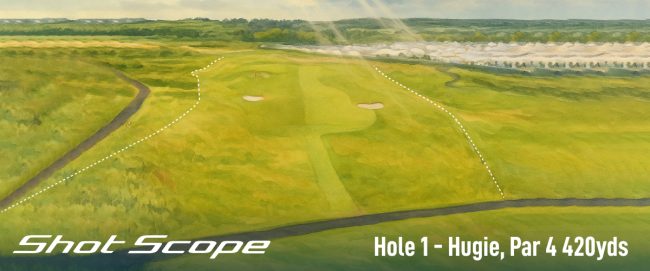Royal Portrush prepares to host The Open Championship for the third time, and with it, we expect to see the game’s best players put through their paces in golf’s purest form, on the links. To learn more about the challenge players must navigate, on-course data experts Shot Scope dived into the data.
A Less than Warm Welcome: Hole 1
Hughie, the first hole at Royal Portrush, at a glance, seems like a straightforward hole with a relatively harmless tee shot. Upon further inspection, out-of-bounds stakes line both sides of the hole, making it one of the most challenging opening holes in major championship golf. In 2019, hometown favorite Rory McIlroy began his Open Championship with an 8, sending his opening drive out of bounds, deflating his positive memories of his previous course record of 61 in 2005.
For amateurs, their opening drives are seven times more likely to find the penalty areas than at any other Open Championship venue. Seven out of every 10 players that embark on a round at Royal Portrush make a bogey or worse on the first with the hole playing +1.06 strokes over par typically. With such a difficult tee shot, it comes as no surprise that only 1 in 4 players hits the green in regulation on the first.
Players approaching the green from the left rough have an average score of +1.3 over par and +1.2 over from the right rough, losing over half a shot on those who find the fairway. This shows not only the importance of keeping it in play off the 1st tee, but finding the fairway is crucial here too. If players suffer from first-tee nerves, Hughie will put them to the test.
Stroke Index 1 Struggles: Hole 4
From the unforgiving welcome of the first hole, players move on to what is arguably the most challenging hole on the course, the fourth hole – Fred Daly’s. The hole boasts the most lost balls off the tee of any on the course, resulting in an average score of 5.33 (+1.33 over par).
The primary culprit for this is the unforgiving right side, where a strong coastal breeze pushes players towards the course boundary. Those who miss right but remain in-bounds play the hole a staggering +1.7 strokes over par, a testament to the devastating consequences of venturing too far in that direction.
A brutal tee shot, an elusive green, and a tricky putting surface where players average 2.25 putts per GIR combine to create the hardest hole on Royal Portrush. Eighty-one percent of players card a bogey or worse on the 4th. The opening holes at Portrush are not for scoring; they are for surviving.
Dogleg Disasters: Hole 8
The front nine does not get any easier after the 4th hole; players must face another tough tee shot on the 8th, Dunluce. A dogleg left, players face an interesting risk-reward scenario off the tee. The temptation to cut the corner is strong, but it can lead to severe consequences if not successful.
Those who do not cover the corner (missing the fairway left) and find their ball play the hole on average +1.4 strokes over par, losing over half a stroke on those who find the fairway. However, one in ten amateurs lose their ball off the tee on Dunluce, substantially increasing the number of penalty shots.
Strategically placed bunkers down the right side encourage players to take the more aggressive line over the dogleg, subtly pushing them towards the trouble they should be avoiding. This combination makes the tee shot a decision-making nightmare.
Shot Scope data reveals that 72 percent of amateurs make bogey or worse on this hole. Finding the fairway, whether it be by cutting the corner or taking a more conservative line, is wise to prevent running up a high score.
As the world’s best golfers descend upon Royal Portrush, their ability to navigate these three challenging tee shots will be a crucial factor in determining who goes on to lift the Claret Jug on Sunday.
If you use a Shot Scope performance tracking product and have played Royal Portrush your data has contributed to the stats in this article.


